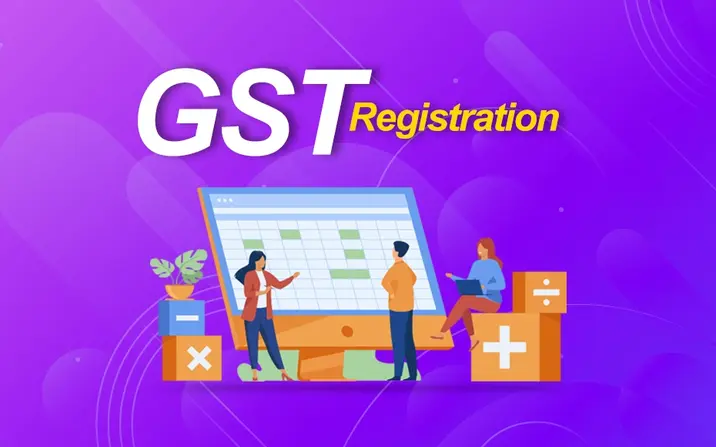Goods and Services Tax (GST) registration is a crucial step for businesses in India. If your business’s annual turnover exceeds Rs.40 lakh, it is mandatory to register as a taxable entity under GST. For businesses in hill and North-Eastern states, the turnover threshold is Rs.10 lakh. This guide will walk you through the GST registration process, eligibility criteria, required documents, penalties for non-registration, and the benefits of registering for GST.
What is GST Registration?
GST registration is the process through which a business is officially recognized by the government as a supplier of goods or services and is authorized to collect GST from customers. The registration is mandatory for businesses whose annual turnover exceeds Rs.40 lakh. However, for businesses in special category states like hill and North-Eastern states, the threshold is Rs.10 lakh. Not registering for GST when required can lead to severe penalties.
Types of GST Registration
1. Normal Taxpayer
Most businesses fall under this category. No deposit is required, and there is no expiry date for this registration.
2. Casual Taxable Person
Suitable for businesses that operate temporarily, such as seasonal shops or stalls. This type requires a deposit equal to the expected GST liability for the duration of the business, which is three months and can be renewed.
3. Composition Taxpayer
This is for small businesses that wish to avail themselves of the Composition Scheme, which allows them to pay a fixed rate of tax on turnover instead of the regular GST rates. However, businesses under this scheme cannot claim input tax credit.
4. Non-Resident Taxable Person
For businesses located outside India but supplying goods or services in India. This registration also requires a deposit equivalent to the expected GST liability for the duration of three months and can be extended.
Online GST Registration Process
The GST registration process is straightforward and can be completed online through the GST portal. Follow these steps:
1. Visit the GST Portal
Go to GST Portal and click on ‘Register Now’ under the ‘Services’ tab.
2. New Registration
Select ‘New Registration’ and fill in the necessary details such as business name, PAN, email, and mobile number.
3. Verification
An OTP will be sent to your email and mobile number. Enter the OTP to receive a Temporary Reference Number (TRN).
4. Login with TRN
Revisit the GST portal, select ‘Register’ and enter the TRN. Complete the form with business details and upload the required documents.
5. Documents Required
- Photographs
- Business address proof
- Bank account details (account number, bank name, branch, and IFSC code)
- Authorization form
- Constitution of the taxpayer (e.g., partnership deed, certificate of incorporation)
6. Verification and Submission
On the ‘Verification’ page, submit the application using one of the following methods.
- Electronic Verification Code (EVC)
- Digital Signature Certificate (DSC)
- e-Sign method with Aadhaar-linked OTP
7. ARN Generation
Upon successful submission, an Application Reference Number (ARN) will be generated. Use this ARN to track your application status on the GST portal.
Eligibility and Documents Required
GST registration is mandatory for:
- Businesses with annual turnover exceeding Rs.40 lakh (Rs.10 lakh for hill and North-Eastern states).
- Individuals who were registered under the previous tax regime.
- Non-resident taxable persons and casual taxable persons.
- E-commerce aggregators and individuals supplying goods through them.
- Input service distributors and agents of a supplier.
- Persons who pay tax under the reverse charge mechanism.
- Service providers with turnover above Rs.20 lakh.
Required documents include:
- PAN card of the business
- Aadhaar card of the authorized signatory
- Proof of business address (rent agreement, property tax receipt)
- Bank account details (account number, bank name, branch, IFSC code)
- Digital signature
- Photographs (in JPEG format, maximum size – 100 KB)
- Constitution of the taxpayer (e.g., partnership deed, certificate of incorporation)
Penalties for Non-Registration
Operating a business without GST registration can attract significant penalties. If caught, the business will face a penalty of 10% of the due tax amount or Rs.10,000, whichever is higher. In cases of deliberate tax evasion, the penalty can be 100% of the due tax amount.
Benefits of GST Registration
1. Legal Recognition: Your business gains legal status and credibility.
2. Uniform Tax Structure: Simplifies tax compliance with a unified tax system.
3. Input Tax Credit: Allows you to claim credit for taxes paid on business purchases.
4. Interstate Trade: Facilitates seamless interstate trade without restrictions.
5. Competitive Advantage: Registered businesses can avail various tax benefits and incentives.
Checking GST Registration Status
To check your GST registration status:
- Visit the GST portal.
- Navigate to ‘Services’ > ‘Registration’ > ‘Track Application Status’.
- Enter your ARN and the captcha code, then click ‘Search’.
- Your application status will be displayed.
Important Points to Note
- GST registration is PAN-based and state-specific.
- A business must register separately in each state where it operates.
- GST registration has no expiration date for regular taxpayers. However, for non-resident and casual taxable persons, it is valid for three months and can be renewed.
Disclaimer
This guide provides an overview of the GST registration process, eligibility, and benefits based on current regulations. GST laws and procedures are subject to change, and it is recommended to consult with a tax professional or refer to the official GST portal for the latest updates and detailed guidance.
By following these steps and guidelines, businesses can ensure compliance with GST regulations and enjoy the benefits that come with being a registered entity under the GST framework.

